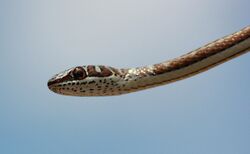Biology:Psammophis
| Psammophis | |
|---|---|

| |
| Psammophis subtaeniatus, Limpopo, South Africa | |
| Scientific classification | |
| Domain: | Eukaryota |
| Kingdom: | Animalia |
| Phylum: | Chordata |
| Class: | Reptilia |
| Order: | Squamata |
| Suborder: | Serpentes |
| Family: | Psammophiidae |
| Genus: | Psammophis Fitzinger, 1826 |
| Species | |
|
33, see text. | |
Psammophis is a genus of snakes in the family Psammophiidae. The genus comprises 33 species, which are found in Africa and Asia.[1] Psammophis are diurnal and prey on lizards and rodents which they actively hunt. All species in the genus are venomous, and the venom is considered mild and not dangerous to humans.[2]
Etymology
The generic name Psammophis was coined by the Austrian herpetologist Leopold Fitzinger in 1826, a compound of the Hellenistic Greek ψαμμο, "sand" + Classical Greek ὄϕις, "snake", thus sand-snake.[3]
Description
In the genus Psammophis the maxillary teeth are 10 to 13 in number, with one or two in the middle much enlarged and fang-like, preceded and followed by an interspace; the two posterior teeth are grooved. The anterior mandibular teeth are long, and the posterior teeth are small. The head is elongated and distinct from the neck, with an angular canthus rostralis. The eye is rather large, with a round pupil. The body is elongated and cylindrical with smooth dorsal scales in 15 or 17 rows at midbody, with apical pits. The ventral scales are rounded or obtusely angulate laterally, and the tail is long with the subcaudals in two rows.[4]
Geographic range
Thirty-three species of Psammophis are known, from Africa and southern Asia.[1] One fossil species, Psammophis odysseus, is known to have inhabited the Iberian Peninsula during the Miocene, indicating that the genus managed to successfully colonize mainland Europe in the wake of the Messinian salinity crisis, only to be extirpated from there shortly afterwards.[5]
Behavior
Psammophis species are chiefly sand-snakes, but they are also found on low bushes.[4]
Diet
Species in the genus Psammophis feed principally on lizards.[4]
Reproduction
All species in the genus Psammophis are oviparous.[6]
Species
The following 35 extant species are recognized as being valid:[1]
- Psammophis aegyptius Marx, 1958
- Psammophis afroccidentalis Trape, Böhme, & Mediannikov, 2019
- Psammophis angolensis (Bocage, 1872)
- Psammophis ansorgii Boulenger, 1905
- Psammophis biseriatus W. Peters, 1881
- Psammophis brevirostris W. Peters, 1881
- Psammophis condanarus (Merrem, 1820)
- Psammophis crucifer (Daudin, 1803)
- Psammophis elegans (Shaw, 1802)
- Psammophis indochinensis M.A. Smith, 1943
- Psammophis jallae Peracca, 1896
- Psammophis leightoni Boulenger, 1902
- Psammophis leithii Günther, 1869
- Psammophis leopardinus Bocage, 1887
- Psammophis lineatus (A.M.C. Duméril, Bibron & A.H.A. Duméril, 1854)
- Psammophis lineolatus (Brandt, 1838)
- Psammophis longifrons Boulenger, 1896
- Psammophis mossambicus W. Peters, 1882
- Psammophis notostictus W. Peters, 1867
- Psammophis orientalis Broadley, 1977
- Psammophis phillipsii (Hallowell, 1844)
- Psammophis praeornatus (Schlegel, 1837)
- Psammophis pulcher Boulenger, 1895
- Psammophis punctulatus A.M.C. Duméril, Bibron & A.H.A. Duméril, 1854
- Psammophis rukwae Broadley, 1966
- Psammophis schokari (Forskål, 1775)
- Psammophis sibilans (Linnaeus, 1758)
- Psammophis subtaeniatus W. Peters, 1882
- Psammophis sudanensis F. Werner, 1919
- Psammophis tanganicus Loveridge, 1940
- Psammophis trigrammus Günther, 1865
- Psammophis turpanensis Chen, Liu, Cai, Li, Wu, & Guo, 2021
- Psammophis zambiensis Hughes, 2002
Fossil species
- †Psammophis odysseus Georgalis, Szyndlar, 2022
Nota bene: A binomial authority in parentheses indicates that the species was originally described in a genus other than Psammophis.
References
- ↑ 1.0 1.1 1.2 Genus Psammophis at The Reptile Database. www.reptile-database.org.
- ↑ Bates MF, Branch WR, Bauer AM, Burger M, Marais J, Alexander GJ, de Villiers MS (editors) (2014). Atlas and Red List of the Reptiles of South Africa, Lesotho and Swaziland. Suricata 1. Pretoria: South African National Biodiversity Institute (SANBI). 485 pp. ISBN:978-1-919976-84-6
- ↑ Oxford English Dictionary, 3rd edition, s.v.
- ↑ 4.0 4.1 4.2 Boulenger GA (1890). The Fauna of British India, Including Ceylon and Burma. Reptilia and Batrachia. London: Secretary of State for India in Council. (Taylor and Francis, printers). xviii + 541 pp. (Genus Psammophis, p. 365, Figure 107).
- ↑ Georgalis, Georgios L.; Szyndlar, Zbigniew (22 February 2022). "First occurrence of Psammophis (Serpentes) from Europe witnesses another Messinian herpetofaunal dispersal from Africa – biogeographic implications and a discussion of the vertebral morphology of psammophiid snakes". The Anatomical Record: ar.24892. doi:10.1002/ar.24892.
- ↑ Branch, Bill (2004). Field Guide to Snakes and other Reptiles of Southern Africa. Third Revised edition, Second impression. Sanibel Island, Florida: Ralph Curtis Books. 399 pp. ISBN:0-88359-042-5. (Genus Psammophis, p. 89).
Further reading
- Fitzinger LI (1826). Neue Classification der Reptilien nach ihre natürlichen Verwandtschaften. Nebst einer Verwandtshafts-tafel und einem Verzeichnisse der Reptilien-Sammlung des K.K. zoologischen Museum's zu Wien. Vienna: J.G. Heubner. five unnumbered + 67 pp. + one plate. (Psammophis, new genus, p. 29). (in German and Latin).
- Trape, Jean-François; Crochet, Pierre-André; Broadley, Donald G.; Sourouille, Patricia; Mané, Youssouph; Burger, Marius; Böhme, Wolfgang; Saleh, Mostafa et al. (2019). "On the Psammophis sibilans group (Serpentes, Lamprophiidae, Psammophiinae) north of 12°S, with the description of a new species from West Africa". Bonn Zoological Bulletin 68 (1): 61–91. doi:10.20363/BZB-2019.68.1.061. ISSN 2190-7307. https://www.zoologicalbulletin.de/BzB_Volumes/Volume_68_1/061_trape_et_al_20190613.pdf. Retrieved 14 April 2021.
Wikidata ☰ Q2578051 entry
 |

